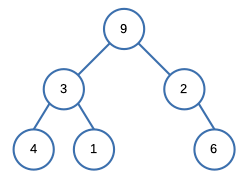LeetCode: 331. Verify Preorder Serialization of a Binary Tree
The Problem
One way to serialize a binary tree is to use preorder traversal. When we encounter a non-null node, we record the node's value. If it is a null node, we record using a sentinel value such as '#'.
Example

The above binary tree can be serialized to the string "9,3,4,#,#,1,#,#,2,#,6,#,#", where '#' represents a null node.
Given a string of comma-separated values preorder, return true if it is a correct preorder traversal serialization of a binary tree.
It is guaranteed that each comma-separated value in the string must be either an integer or a character '#' representing null pointer.
You may assume that the input format is always valid.
- For example, it could never contain two consecutive commas, such as
"1,,3".
Note: You are not allowed to reconstruct the tree.
Input: preorder = "9,3,4,#,#,1,#,#,2,#,6,#,#"
Output: trueConstraints:
1 <= preorder.length <= 104preorderconsist of integers in the range[0, 100]and'#'separated by commas','.
Solution
We chose an iterative approach to solve the problem. When we evaluated our solution on the LeetCode platform, here are the results:

Here's the code that led us to this result.
bool isValidSerialization(string preorder) {
stringstream str(preorder);
string node;
int count = 1;
while(getline(str, node, ',')){
--count;
if(count < 0) return false;
if(node != "#") count = count + 2;
}
return count == 0;
}Here's a simplified explanation:
- It starts by splitting the
preorderstring into individual nodes using a comma (',') as the delimiter. - It initializes a variable
countto 1. This variable represents the number of available slots for nodes in the tree.
It iterates through the nodes one by one:
- For each node encountered, it decrements
countby 1. - If
countbecomes negative at any point, it means there are more nodes in the traversal than slots available, which is not valid. In this case, it returnsfalse. - If the node is not a '#' (representing a valid node), it means there are two more slots available for child nodes, so it increments
countby 2.
- After processing all nodes, it checks if
countis back to 0. If it is, it means the traversal is valid, and it returnstrue; otherwise, it returnsfalse.
